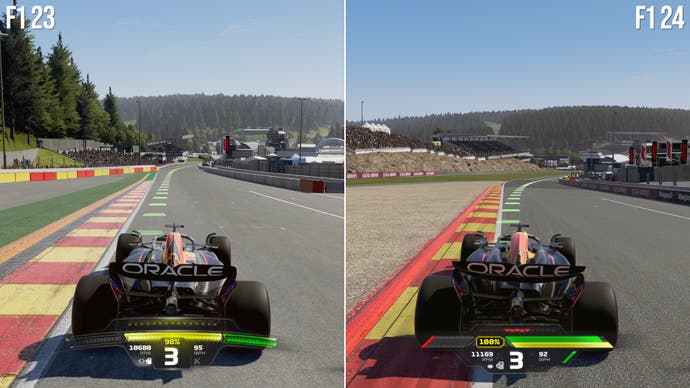Having a new F1 game release annually creates a real challenge to innovate – to truly rework its visuals and features – and so with F1 24 we have a more iterative entry this time around. With that being said, there are key upgrades. In particular F1 24 brings entirely reworked tracks, with fan favourites like Silverstone and Circuit de Spa – and more – getting major overhauls compared to F1 23. Equally, the drivers get a facelift. All 20 official F1 drivers are re-scanned in to create a more up-to-date likeness, with improved hair rendering to boot. At its core, developer Codemasters continues to use its EGO engine here and who could blame them – it’s a proven, dependable foundation, a technology that’s served the team well. It’s scalable. It’s fully cross-gen, and on PC and newer consoles it’s capable of ray tracing. Fundamentally the question has to be raised though: are we getting a next generation F1 experience out of this engine? Is it a radical difference from last year’s effort?
First up, being an even numbered year, the Braking Point story mode is given a miss this time. Potentially we’ll see the next chapter in 2025, but for now, the career mode is the real focus for solo play. On the plus side, new cutscenes are added between each race, essentially putting the game’s new driver models in clear view. These are closely remodelled – with results now better reflecting their style in the 2024 campaign. We get more accurate skin and eye shaders and a huge improvement to hair rendering in particular, with Lewis Hamilton, and Fernando Alonso letting their tresses flow freely. Funnily enough, the limits of F1 23’s hair rendering have been disguised thus far by having each wear their team caps. On a general level, every freckle and dimple is recreated for F1 24 and the way light interacts with skin and hair creates a much more authentic result.
Next up, a lucky quartet of tracks see a complete overhaul this year. Silverstone in the UK, Circuit de Spa in Belgium, the Lusail International Circuit in Qatar and finally Jeddah Corniche Circuit in Saudi Arabia are brought up to date with a meticulous re-profiling of the road from Codemasters. Comparing F1 23 to F1 24, elevation changes are factored into every incline, turn and strait.
So for example, the opening chicane of Circuit De Spa will handle differently to last year. New materials are deployed for the asphalt, the gravel, the metal road barriers. There’s a more modern look to the off-track fairings, too. Even distant backdrop detail like trees and buildings are replaced in this year’s edition – or at least, embellished with more up-to-date detail. In the case of the Lusail track there are extra barriers, new curbs, more trees, more stands. And meanwhile Jeddah Corniche features a more colourful steak of trackside artwork. Visually speaking it’s not always a dramatic difference on every corner. After all, it must stay in keeping with real-world changes, but where Codemasters has put its energy it’s satisfying to see these tracks modernised.
In terms of platform comparisons, the series history is solid and so it is here in F1 24. All three offer a matching feature set for F1 24, with the only key exception being that Series S once again is shorn of the 120fps ‘performance’ mode. All target 60 frames per second well though, with identical visual features. In terms of resolutions, PS5 and Series X continue to run at a native 4K resolution, dynamically adjusting to 1800p lowest when the engine is stressed. The drop in pixel count is seamless. It’s invisible in motion, and functions as a sensible fallback to ensure that each race always holds 60fps. On Series S meanwhile, we have a less impressive 1080p target in place. 1080p is the typical value, based on most tests – and in fairness, rarely if ever drops under that target. It’s a softer picture on Series S though, no doubt. On the upside, it does at least hold up to Series X and PS5 in shadows, ambient occlusion and texture quality – and even ray tracing features make the grade on all three.
Ray traced shadows, ambient occlusion, reflections and the recently added dynamic diffuse global illumination (DDGI) all engage on console. The catch, as with last year though, is that ray tracing is purely limited to F1 24’s menus, pre-race build-ups and replays. These moments also often pay a clear price in performance, with frame-rates delving down to the 20-40fps range. Actual gameplay switches to typical rasterised techniques for reflections, shadows, and ambient occlusion otherwise. Once you’re revving at the starting grid, it’s this switch that makes 60fps viable on PS5, Series X and S.
As ever, the PC version is the best way to get a complete suite of ray tracing features in actual gameplay. First up, reflections. Once again the screen-space technique used on PS5 looks great on its own terms, with the detail of the advertising boards being mirrored cleanly across the wet tarmac. However, this SSR approach has limits in simulating material interaction. The oncoming light is not diffused accurately, meaning the mirror image is too bright, and too clean across the asphalt, and the layer of water build-up. With ray tracing engaged on PC though, these reflections sit more naturally, and light’s strengh is distorted as it should be. The light bounce from each billboard and barrier is diffused by the gravel material, creating a more muted reflection: a less vivid mirroring of that detail.
It’s the same deal with ray-traced shadows: long shadow lines, cast from the buildings high above, are diffused. They’re softer and more natural on PC, owing to the way ray tracing simulates the way shadow detail spreads at range from the occluding object. More subtle is the impact of ray traced ambient occlusion and DDGI. These fill out the corners of the cockpit with refracted colour and shade from the driver. Such ray traced extras are missed in gameplay on the console side, but in fairness, all of this is a concession to make 60fps and even 120fps on PS5 and Series X possible.
Performance is a non-issue in F1 24 where it matters. There’s simply no problem on PS5, Series X or S in hitting 60fps during a race. Across the board, on every track, these machines truly deliver during gameplay, just like last year. Complex tracks like Monaco with 20 cars in view pose no problem, and likewise racing in heavy rain doesn’t trigger any dips under 60. Even Xbox Series S is a robust performer, albeit thanks to its unambitious 1080p target.



The only problem – as with F1 23 last year – is the cutscenes. Too many scripted moments drop into the 20-30fps region, with full-screen tearing in view. It’s an obvious blemish on the game, standing out all the more given the solid frame-rate during the on-track racing. Any scripted scene, or replay tends to descend into these choppy low figures – and it’s no coincidence that it’s just as ray traced features engage. All of this applies for PS5, Series X and S in equal measure. The good news is that F1 24 continues to hit the target where it really matters: in gameplay. Every millisecond counts in a pure racing simulator – and even with the reworked tracks and drivers, there’s no impact to performance this year.
The turnout for F1 24 again reads as a stop-gap entry in the series – one that settles for iteration over outright innovation. The remodelled tracks and newly scanned drivers are welcome upgrades this year of course, but key issues from last year have not been addressed such as the often choppy performance during cutscenes – where ray tracing on consoles forces seriously low frame-rates. It’s a surprise given the polish of the on-track racing on PS5, Series X and S, that these huge drops are being overlooked. Otherwise the quality of the experience is intact.
Looking to the future, we’re promised “further visual enhancements” are coming post launch. And if it happens to be a substantial change to what we’ve got in F1 24 today, we’ll be sure to report back. Otherwise, the pressure is on next year’s entry – F1 25 – to show us a more ambitious push to upgrade the console experience.




